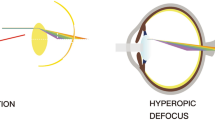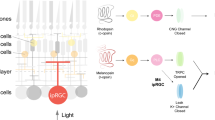Summary
After intense orange adapting exposures that convert 80% of the rhodopsin in the eye to metarhodopsin, rhabdoms become covered with accessory pigment and appear to lose some microvillar order. Only after a delay of hours or even days is the metarhodopsin replaced by rhodopsin (Cronin and Goldsmith 1984). After 24 h of dark adaptation, when there has been little recovery of visual pigment, the photoreceptor cells have normal resting potentials and input resistances, and the reversal potential of the light response is 10–15 mV (inside positive), unchanged from controls. The log V vs log I curve is shifted about 0.6 log units to the right on the energy axis, quantitatively consistent with the decrease in the probability of quantum catch expected from the lowered concentration of rhodopsin in the rhabdoms. Furthermore, at 24 h the photoreceptors exhibit a broader spectral sensitivity than controls, which is also expected from accumulations of metarhodopsin in the rhabdoms. In three other respects, however, the transduction process appears to be light adapted: (i) The voltage responses are more phasic than those of control photoreceptors. (ii) The relatively larger effect (compared to controls) of low extracellular Ca++ (1 mmol/1 EGTA) in potentiating the photoresponses suggests that the photoreceptors may have elevated levels of free cytoplasmic Ca++. (iii) The saturating depolarization is only about 30% as large as the maximal receptor potentials of contralateral, dark controls, and by that measure the log V-log I curve is shifted downward by 0.54 log units. The gain (change in conductance per absorbed photon) therefore appears to have been diminished.
Similar content being viewed by others
References
Alpern M, Rushton WAH, Torii S (1970a) The size of rod signals. J Physiol 206:193–208
Alpern M, Rushton WAH, Torii S (1970b) The attenuation of rod signals by backgrounds. J Physiol 206:209–227
Alpern M, Rushton WAH, Torii S (1970c) Signals from cones. J Physiol 207:463–475
Boynton RM, Whitten DM (1970) Visual adaptation in monkey cones: recordings of late receptor potentials. Science 177:1423–1426
Brown JE, Blinks JR (1974) Changes in intracellular free calcium concentration during illumination of invertebrate photoreceptors: Detection with aequorin. J Gen Physiol 64:643–665
Brown JE, Coles JA (1979) Saturation of the response to light inLimulus ventral photoreceptors. J Physiol 296:373–392
Bruno MS, Barnes SN, Goldsmith TH (1977) The visual pigment and visual cycle of the lobster,Homarus. J Comp Physiol 120:123–142
Cronin TW, Goldsmith TH (1982) Quantum efficiency and photosensitivity of the rhodopsin ↔ metarhodopsin conversion in crayfish photoreceptors. Photochem Photobiol 36:447–454
Cronin TW, Goldsmith TH (1984) Dark regeneration of rhodopsin in crayfish photoreceptors. J Gen Physiol 84:63–81
Dowling JE (1963) Neural and photochemical mechanisms of visual adaptation in the rat. J Gen Physiol 46:1287–1301
Fein A, DeVoe RD (1973) Adaptation in the ventral eye ofLimulus is functionally independent of the photochemical cycle, membrane potential, and membrane resistance. J Gen Physiol 61:273–289
Goldsmith TH (1978) The effects of screening pigments on the spectral sensitivity of some Crustacea with scotopic (superposition) eyes. Vision Res 18:475–482
Hamdorf K, Rosner G (1973) Adaptation und Photoregeneration im Fliegenauge. J Comp Physiol 86:281–293
Hamdorf K, Paulsen R, Schwemer J (1973) Photoregeneration and sensitivity control of photoreceptors of invertebrates. In: Langer H (ed) Biochemistry and physiology of visual pigments. Springer, Berlin Heidelberg New York, pp 155–166
Harary H, Brown JE (1984) Spatially nonuniform changes in intracellular calcium ion concentrations. Science 224:292–294
Harreveld AD van (1936) A physiological solution for freshwater crustaceans. Proc Soc Exp Biol Med 34:428–432
Levy S, Fein A (1985) Relationship between light sensitivity and intracellular free Ca-concentration inLimulus ventral photoreceptors. A quantitative study using Ca-selective microelectrodes. J Gen Physiol 85:805–841
Lisman JE, Brown JE (1975 a) Light-induced changes of sensitivity inLimulus ventral photoreceptors. J Gen Physiol 66:473–488
Lisman JE, Brown JE (1975b) Effects of intracellular injection of calcium buffers on light adaptation. J Gen Physiol 66:489–706
Lisman JE, Strong JA (1979) The initiation of excitation and light adaptation inLimulus ventral photoreceptors. J Gen Physiol 73:219–243
Muller KJ (1966) An electrophysiological investigation of retinular cells of the crayfishProcambarus clarkii. PhD thesis, Massachusetts Institute of Technology
Naka K-I, Rushton WAH (1966) S-potentials from colour units in the retina of fish (Cyprinidae). J Physiol 185:536–555
Seldin EB, White RH, Brown PK (1972) Spectral sensitivty of larval mosquito ocelli. J Gen Physiol 59:415–420
Stieve H, Hanani M (1976) Light and dark adaptation of crayfish visual cells depending on extracellular calcium concentration. Z Naturforsch 31c: 324–327
Author information
Authors and Affiliations
Rights and permissions
About this article
Cite this article
Cummins, D.R., Goldsmith, T.H. Responses of crayfish photoreceptor cells following intense light adaptation. J. Comp. Physiol. 158, 35–42 (1986). https://doi.org/10.1007/BF00614518
Accepted:
Issue Date:
DOI: https://doi.org/10.1007/BF00614518




